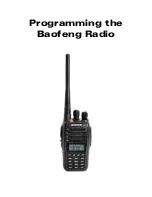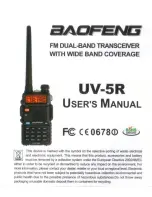
28
29
English
English
Transmit
For transmission hold the PTT key (8) until the end of the message. For best sound
quality, talk into the microphone (4) with normal voice at a distance of approximatly
10 cm. During transmission the control LED (6) lights red.
Upon release of the PTT key (8) the radio returns automatically into reception mode.
Reception
Upon reception of a signal, the LED (6) lights green.
If the selected frequency is decoded with a CTCSS- / DCS-code, all signals that are
encoded with a different code will be muted. The green LED will light but no signal
will be audible.
KEY FUNCTIONS
PTT Key
The PTT key (8) is located ont the left side of the radio. Pressing the PTT key will
switch the radio into transmission mode. The LED (6) will light red.
Multi-Function Keys
The multi function keys SK1 and SK2 (9) are located below the PTT key (8), the orange
button TK1 (7) is located on top of the radio. They are programmable with the software
T-UP33. Two functions can be assigned to one multi-function key. These two different
functions are triggered by pressing the key shortly and long:
Monitor*
Scan
Noise ch tmp remove
VOX
H/L Power
Power detect
Work Alone
Encrypt
EMI
Talk Around
Priv ch scan
Reverse
Area Switch
One Key Call 1
One Key Call 2
One Key Call 3
One Key Call 4 One Key Call 5
* only long press
default programming of the keys:
TK (7): Area Switch
SK 1 top (9): Monitor
SK 2 bottom (9): Scan
With activated
Voice Broadcast
, some functions are announced. Others will use a
higher tone to indicate the active state and a lower tone for the passive state of the
function.
Monitor:
On the analog channels, this functions serves as Squelch Off. Weak signals will be au-
dible and if no signal is present, you will hear the typical constant noise of the frequency.
On the digital channels, this function serves as Monitor. Any signal, despite it’s coding,
will be audible. Incoming single- and group calls with an unmatching code can be
monitored.
Scan:
All channels of the scan list are searched for signals according to the programmed
scan parameters. Via software, each programmed channel can be either added to
the scan list or deleted from it. These parameters are available for the scan function:
Scan Mode - Time/Carrier:
Either the radio remains only for a certain time (
Dwell Time
) on the busy channel
(
Time
) or the scan function pauses as long until the signal ends (
Carrier
).
Tone Scan Mode
Not Detect
: Scan ignores CTCSS/DCS coding as a search criteria.
Non-Priority Ch
: The priority channel is exluded from the scan list.
Priority Ch
: Priority scan; adds the priority channel in between each channel of
the scan list.
All Channel
: Only signals with a matching CTCSS/DCS code will be recognized.
Priority Channel - Priority Ch:
Defines the priority channel for the function priority scan (
Pri Ch Scan).
Talk Back:
Allows to transmit - talk back - on a detected channel.
Scan Start/End Beep:
Warning tone informs about the start and the end of the scan function.
Dwell Time:
Sets the time remaining on a detected channel with the scan mode setting
Time
.
Rx/Tx Resume Delay Time:
Determines how long the radio remains on a channel after transmission or reception
before the scan function is continued.
Scan Tx Channel:
If the setting
Talk Back
is activated, transmission is possible while the scan function
is acitve or paused. This function defines on what channel will be transmitted after
the expiration of the
Dwell Time
.
Entry Channel before Scan
:
starting channel of the scan function.
Last Active Channel
:
channels where last signal has been detected
Specified Channel
:
specified channel
Specified Channel:
Defines the channel for the
Scan Tx Channel
mode
Specified Channel
.
TeCom_IP-DA32_manual-6mod:Layout 1 3/24/2016 1:17 PM Page 28















































